Improving customer experience starts with data, and there’s a lot of it these days. After all, global retail ecommerce sales alone are projected to reach over $8 trillion by 2026. That’s millions of customers, billions of searches, and trillions of actions — daily.
But as an enterprise ecommerce company, how do you efficiently sort through big data while maximizing human potential and still hitting key business goals?
The short answer: It’s an art and a science. The long answer: Learn everything there is to know about searchandising, which involves partnering with tech to convert data into actionable decisions that satisfy customers and drive tangible results — without overexerting your merchandising team.
Don't have time to read?
Watch Constructor's webinar - The Art and Science of Searchandising - in collaboration with AWS now:
What Is Searchandising?
According to Ronak Shah, Partner Solutions Architect for Retail & CPG at Amazon Web Services (AWS), “searchandising is the merchant’s ability to manage the user experience in various listing pages on multiple channels.” Those pages could be search results, category pages, local stores, and so forth.
Also spelled searchandizing, it comes from the word ‘merchandising’ in retail. And it primarily includes creating a personalized customer experience based on rules, which could be boosting products, blocklisting, defining synonyms, etc.
The history of searchandising
Eli Finkelshteyn, CEO and co-founder of Constructor, shares that searchandising hasn’t always been associated with its present-day meaning.
Back in the early 2000s, searchandising meant something completely different: ads within retail websites. The earliest uses of what it means now surfaced around 2015.
In those last eight years, the term has been used in two different ways:
- Traditionally, searchandising was used to fix underlying issues within product discovery engines (think: removing poor search results for a query, adjusting for typo tolerance, etc.). But these patchwork approaches are quickly disappearing, thanks to new tech.
- In the past couple of years, searchandising has transitioned into being more of an art and a science. Its purpose is to build brand value and solve point solutions within the business (more on this later).
While industry standards still somewhat imply it’s limited to Search, searchandising actually applies across Browse, Recommendations, Collections, Autosuggest, landing pages, campaigns, and more.
And when searchandising across ecommerce pages, this can increase revenue and give teams back hours in their day to invest in creating more holistic strategies.

Why Is Searchandising Important?
When treated as an art and a science, the benefits of searchandising are many for ecommerce companies:
It improves the shopper experience
Leveraging human domain knowledge in tandem with data improves the shopper experience by allowing merchants to deliver consistent UX across the product discovery space.
And data doesn’t have to be online. Merchants can also use offline data to inform the omnichannel customer journey, creating experiences that better match specific segments while improving in-store experiences.
It supplements your brick-and-mortar experience
Over 50% of U.S. consumers prefer brick-and-mortar stores over other channels. Yet huge value remains in leveraging digital channels, especially for those ecommerce brands who treat them as an extension of their overall strategy.
It’s a merchant’s job to treat the system the way they want to present products to their end user — with the end goal of providing the same caliber of experience across channels.
It builds brand value and solves business pain points
Searchandising can build brand value and increase operational efficiency within the business, especially when merchants use their domain knowledge together with data.
This is thanks to the new approach to searchandising.
For instance, a merchant may decide to bury items on sale if they don’t want to appear as a discount retailer, even if their KPIs are conversions or revenue. That decision is an art. They’re deciding it’s worthwhile for the brand image despite purchasing trends.
Or imagine the same merchant catches wind of a trendy new product in their space, but it’s so new that there isn’t any data yet to support boosting it in search algorithms. They may decide to still push the new product anyway, knowing that it’ll connect better with customers.
What are Challenges Large Ecommerce Companies Face With Searchandising?

The larger the ecommerce company, the more complicated their searchandising experiences within their product discovery platform.
Rules become unmanageable
At some point, enterprise merchandisers end up trying to manage thousands of rules. On top of this, there may be confusion as multiple merchandisers try to optimize for multiple categories. Or, multiple people are in charge of growing their own category.
In short, searchandising becomes unwieldy and unscalable.
Product discovery platforms give mediocre results
Keyword-based search engines give mediocre search results. And these results warrant manual intervention from your merchandising team via searchandising — i.e., creating more rules to adjust for typo tolerance and synonyms, playing around with tie-breaking algorithms, etc.
In the long term, this ends up costing your company ROI.
Personalization and search aren’t synchronized
Enterprise merchandisers sometimes treat personalization and search as two different workstreams. And because they’re not synchronized, merchandisers end up optimizing only one, which can negatively affect KPIs.
There are data silos
Without the right tech, enterprise merchants may struggle with processing and acting on fast-moving data, like inventory and pricing. It may also be challenging for them to leverage first-party data to improve the customer experience.
Imagine there’s a lapse in the searchandising system, and merchandisers may not know how quickly products are selling or even if they’re selling out. If said products are boosted on the first page, that’s a recipe for disaster.
Manual intervention takes time
Imagine you find products in your catalog with potential, and you want to increase their exposure. Without the proper tools, it’s all manual. You manually boost them, manually time box over a sale, and even manually dig into data afterwards to analyze results.
This takes time away from needle-moving strategic work.
Your product discovery solution should provide you the necessary tools to tweak the system and automatically give feedback on where value creation happens.
Merchant Tools to Overcome Searchandising Challenges
Without a doubt, merchant tools form the foundation of solid searchandising, allowing merchandisers to help customers find what they need faster while positively impacting business KPIs.
Boosting and burying
One way merchandisers can control the products displayed across their ecommerce website is via boosting and burying search results.
These two powerful merchant actions can be manually performed based on goals around inventory velocity, margins, brands, location, and more.
For example, merchants can manually boost private label products and bury competitors’ products in search results. They can also boost items in overstock to make room for new models or bury low-stock products until inventory is replenished — all while layering business KPIs on top of rules.
Merchants can also choose to let AI rank products based on aggregate data and search intent.
For instance, in the searchandising dashboard below, AI created rules to automatically bury ‘short sleeve shirts’ and ‘short sleeve tees’ for the search term “shorts.” This is due to gleaned search intent based on aggregate clickstream data collected from this retailer’s site.

Slotting
Sometimes, merely boosting isn’t enough. You might want to manually “slot” a new or private label product at the top of search results, especially if you want to prioritize own-brand products or promote partner products during a specific time frame.
By toggling over to the Manual tab in the same screenshot from above, you can see the merchant chose to manually slot products into results for the search term “shorts” as well.
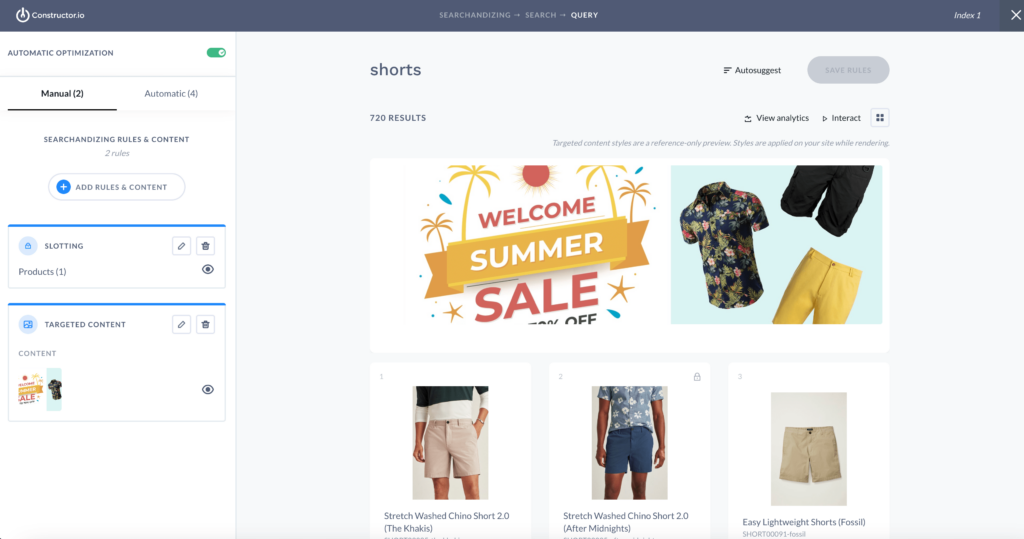
Blocklisting
Blocklisting allows merchants to hide products from results without needing to re-upload a full catalog.
For example, merchants can hide out-of-stock products, or products that are priced incorrectly. They can also blocklist products for a specific user segment (like marijuana products for children).
These capabilities allow merchandisers to continue customizing results that meet both customer and business needs — without tacking on added hours of mundane work.
The Ultimate Guide to Searchandising with Constructor
In this comprehensive guide, learn exactly how our Search and Browse Capabilities, Merchant Intelligence, and Native Commerce Core empower merchandisers and product managers to consistently create personalized shopping experiences that don't just convert, but drive business KPIs.
Creating custom themed landing pages
Getting ready for Father’s Day promotions? Or even Labor Day weekend? Robust merchant tools allow you to customize themed collections of products to better cater to certain searches.
And Collections don’t have to be events based. For example, beauty retailer Sephora has a “Sephora Collection” page that contains only private label products.

Shoppers who engage with Sephora’s own-brand products will be shown more private label options throughout the rest of their shopping experience — thanks to clickstream data, or behavioral data.
And all Sephora had to do was set up appropriate rules and conditions in their product discovery dashboard, similar to the example from the rugs retailer below.

Leveraging search intelligence
It’s impossible to manually analyze data from millions of daily users.
The solution is to leverage a search intelligence tool powered by AI and first-party clickstream data to surface analytics, insights, and behavior patterns at scale. Search intelligence also:
- Identifies opportunities for merchants to intervene
- Automates merchandising gruntwork
- Warns merchants of potential oversights
A search intelligence platform like the one pictured below can even alert merchandisers when the rules have been left unmodified for a while (i.e., more than two months). This enables merchants to keep a closer eye on rules set during specific time frames and for specific seasons.
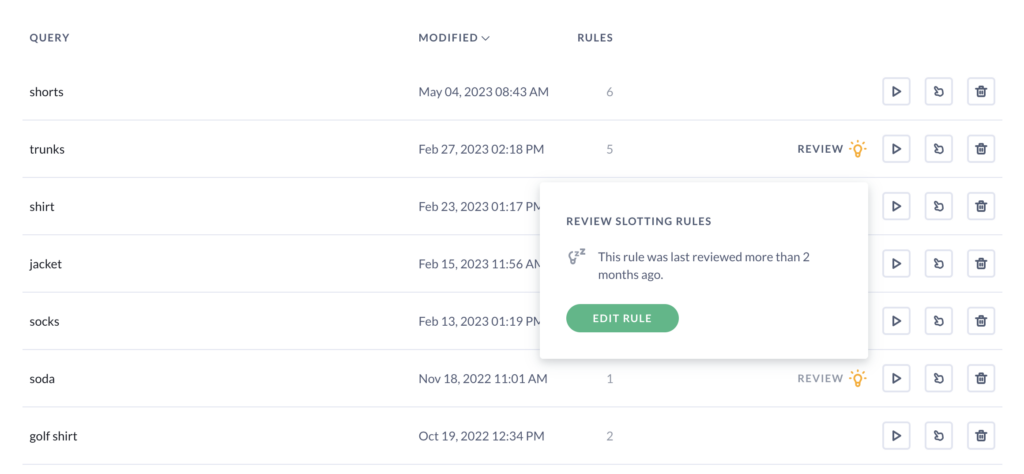
Using facets
Facets are product attributes that allow users to further refine their results on search, category, or collection pages. Depending on the industry, common facets are price range, brand, size, color etc. Searches can then be further refined via filters.
An example of this is pictured below on Target Australia’s website, where you can see the dropdown filter menu for the facet Color.

And just like search results, facets and filters should be dynamic. If a user searches for “blazer,” the search results page may show facets like “fit” and “material” higher in the navigation. If they’re searching for “pants,” options like “slim fit” or “inseam” would be more readily seen.
We can see this in action with Target Australia below, where they provide facet options for the query “women’s shoes” that are different from those for the query “women’s earrings.” Showing the right facets at the right time is one part of providing improved product ranking and personalization that brought them a 9% lift in search revenue.
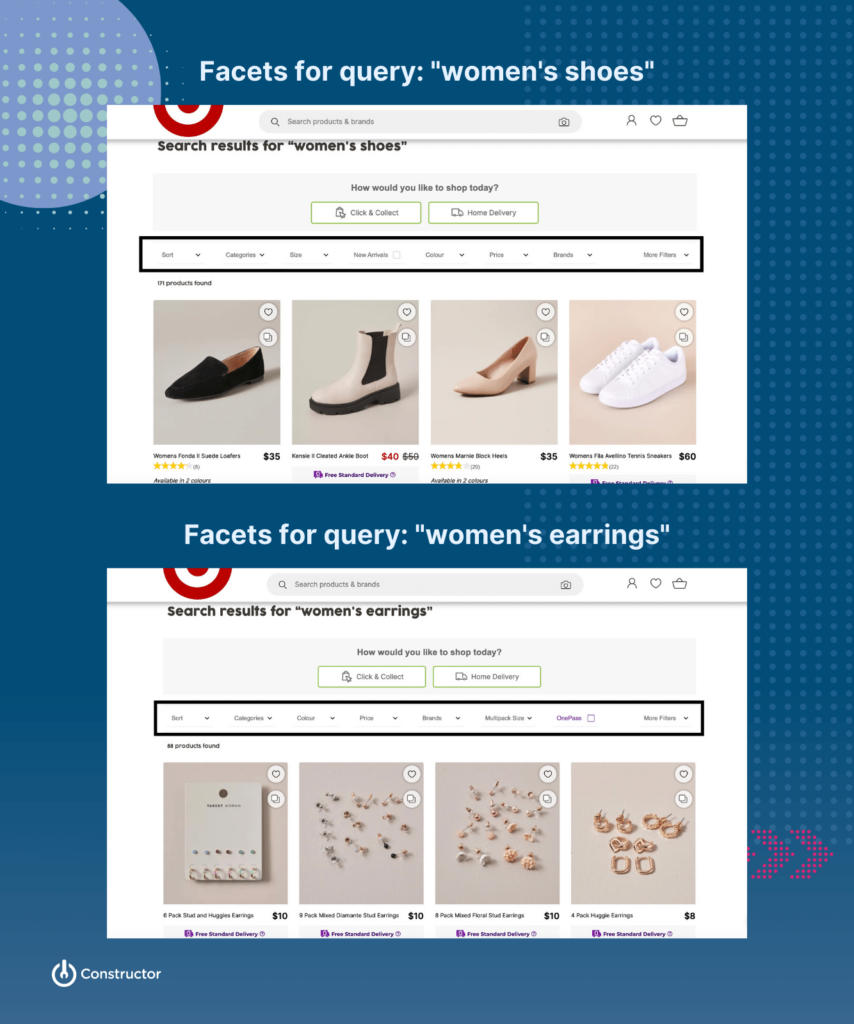
But these sorts of results aren’t all machine-driven.
With strategic intervention, your team can do advanced facet management — hide, slot, sort, and merge facets — to improve the customer shopping experience. They can also set global facet rules across all pages where a specific facet appears.
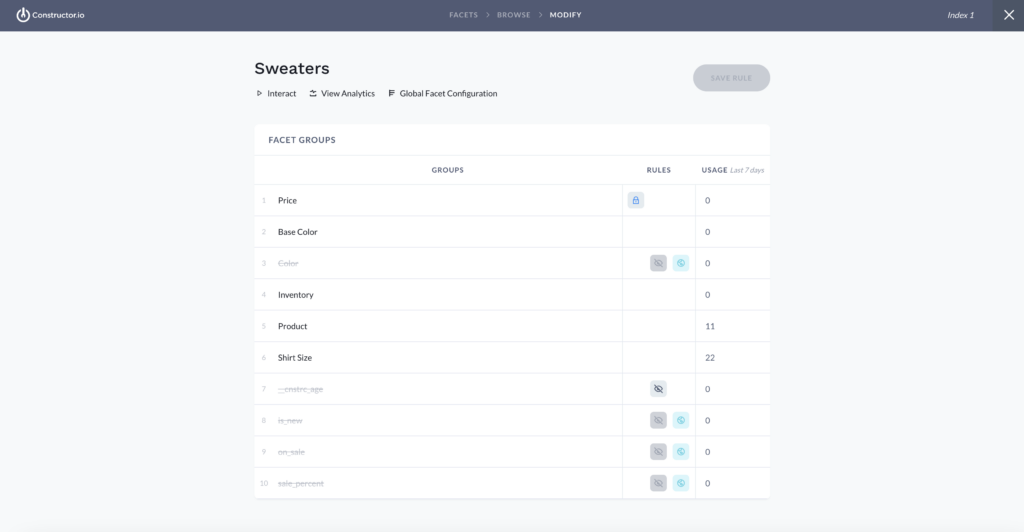
And depending on your current product discovery platform, you can also analyze the facet usage data to see how customers are interacting with them.
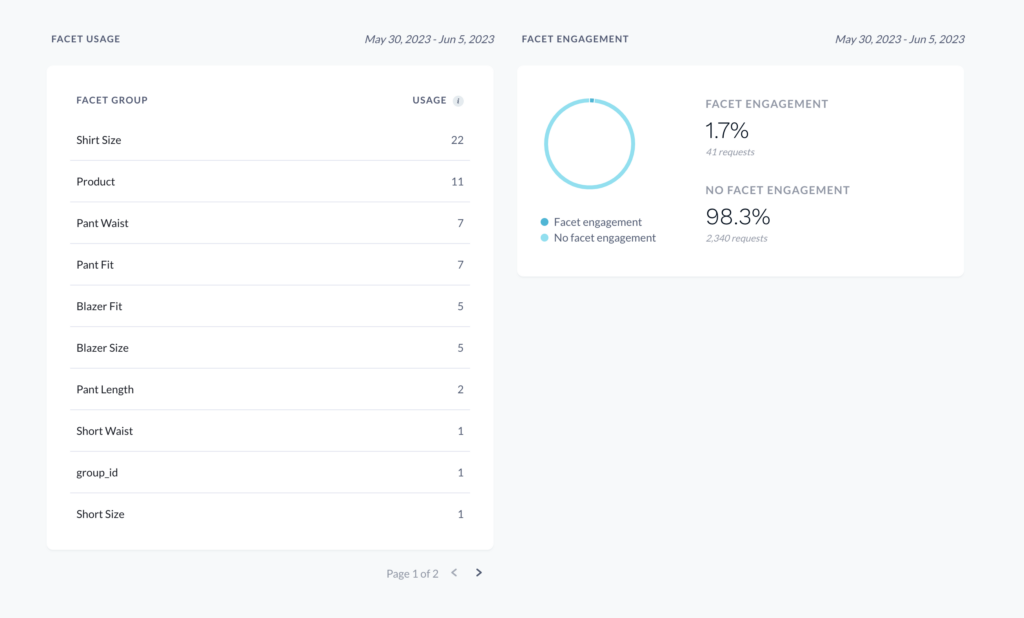
Searchandising Made Easier With AI and ML Tools
Over half of merchandising employees report that their teams spend over 20 hours per week on manual merchandising activities.
“Some manual work is important, especially the work that substantially improves the customer experience,” said Rory Dennis, co-founder and general manager of North America at Amplience.
“But when there’s a lot of it, the question is can we streamline that work to minutes instead of hours? Can we leverage technology solutions so that team talent isn’t wasted on manual workarounds to common ecommerce problems?”
The answer is yes, you can streamline work using AI-assisted merchant tools. Here’s how they make searchandising easier.
They can augment and interpret data more quickly
Aside from leveraging clickstream data to personalize search results, select AI- and ML-powered engines can augment data before it reaches the search system, thus saving merchandisers time.
For example, they can learn from image attributes based on prior input and the specific domain at hand. This tech alerts merchandisers of missing key attributes so they can be fixed before uploaded to the search engine. This process is known as attribute enrichment.
Merchandising is also made easier thanks to data interpretation by transformers (the “t” in ChatGPT) and large language models (LLMs). These models understand the semantic meaning of long queries better and, therefore, produce more relevant results.
Responsible vendors understand the rules of engagement to using transformers in years to come, starting with experimentation being a prerequisite.
They allow merchandisers to optimize for a business metric
Traditionally, keyword-based internal site search engines would return results based on word frequency and deemed relevance. But over time, we’ve seen that search relevance isn’t the most important ecommerce metric — needle-moving KPIs are.
Enter AI and ML.
Instead of optimizing for relevance, AI and ML allow merchandisers to optimize for ecommerce business metrics, like conversions, revenue, profit, etc.
Once those metrics are set, the tech automatically solves for the intended KPIs and simultaneously handles typos, synonyms, etc. while learning from clickstream to show products to users that are optimized for the business metric.
They open up space for strategic work
Simply put, AI- and ML-powered tech gets your merchandising team to a base level, which opens up time for them to do more strategic work — like managing by exception and creating unique value.
AI and ML will never accomplish that due to lack of business knowledge.
Wade Through The Data — With Help
Searchandising is an art and a science. An art that depends upon human strategy and potential to thrive. And a science that requires data at its core.
For ecommerce companies that aspire to stay ahead of competition in our fast-paced world, tech is no longer a nice-to-have. It’s a need-to-have.
But not just any tech, yet a solution that streamlines repetitive tasks, automatically surfaces insights and analytics, and serves as a reliable partner that your merchandising team can leverage 24/7.
The Ultimate Guide to Searchandising with Constructor
Learn how ecommerce AI – not just any AI – improves KPIs and team efficiency.

